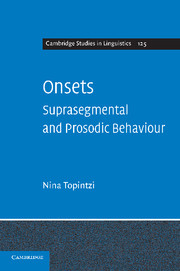Book contents
- Frontmatter
- Contents
- Preface
- Acknowledgements
- 1 Onsets and weight: the theory
- 2 Onsets and stress
- 3 Onsets and compensatory lengthening
- 4 Onsets and word minimality
- 5 Onsets and geminates
- 6 Other real and not so real onset-sensitive data: brief case-studies
- 7 Conclusion and discussion of alternatives
- References
- Subject index
- Language index
7 - Conclusion and discussion of alternatives
Published online by Cambridge University Press: 06 July 2010
- Frontmatter
- Contents
- Preface
- Acknowledgements
- 1 Onsets and weight: the theory
- 2 Onsets and stress
- 3 Onsets and compensatory lengthening
- 4 Onsets and word minimality
- 5 Onsets and geminates
- 6 Other real and not so real onset-sensitive data: brief case-studies
- 7 Conclusion and discussion of alternatives
- References
- Subject index
- Language index
Summary
The book's main themes
This book has been about onsets and their behaviour in suprasegmental phonology. Having discarded the stipulation that most other phonological accounts take for granted, namely that onsets are prosodically inert, it has been argued instead that onsets may be moraic or not on a language-specific basis. This brings them on a par with codas. And like codas, the moraicity of onsets is regulated by markedness considerations or is subject to underlying specifications.
In the latter instance, moraicity is lexical, hence unpredictable, leading to onset geminates. In the former, though, the claim has been that moraicity is basically down to voicing, and that in this type of moraic onset, voiceless onsets always make better mora bearers than their voiced counterparts. However, in the case of nuclei and codas, the more general concept of sonority takes over, because in those positions, voicing is not contrastive or reliable enough. Such cases have been tackled elsewhere (see Zec 1988, 1995; Morén 2001).
Throughout the book, these ideas have received empirical support from a wide range of data and phenomena. We have looked at stress, word minimality, compensatory lengthening, gemination, reduplication, tone, and all have highlighted the important role onsets play in suprasegmental phonology. In the process, various formal, technical and analytical issues have been dealt with in order to provide a comprehensive theory of onset weight. These key ideas and themes are summarized in (1) and discussed in more detail immediately afterwards.
- Type
- Chapter
- Information
- OnsetsSuprasegmental and Prosodic Behaviour, pp. 230 - 246Publisher: Cambridge University PressPrint publication year: 2010

